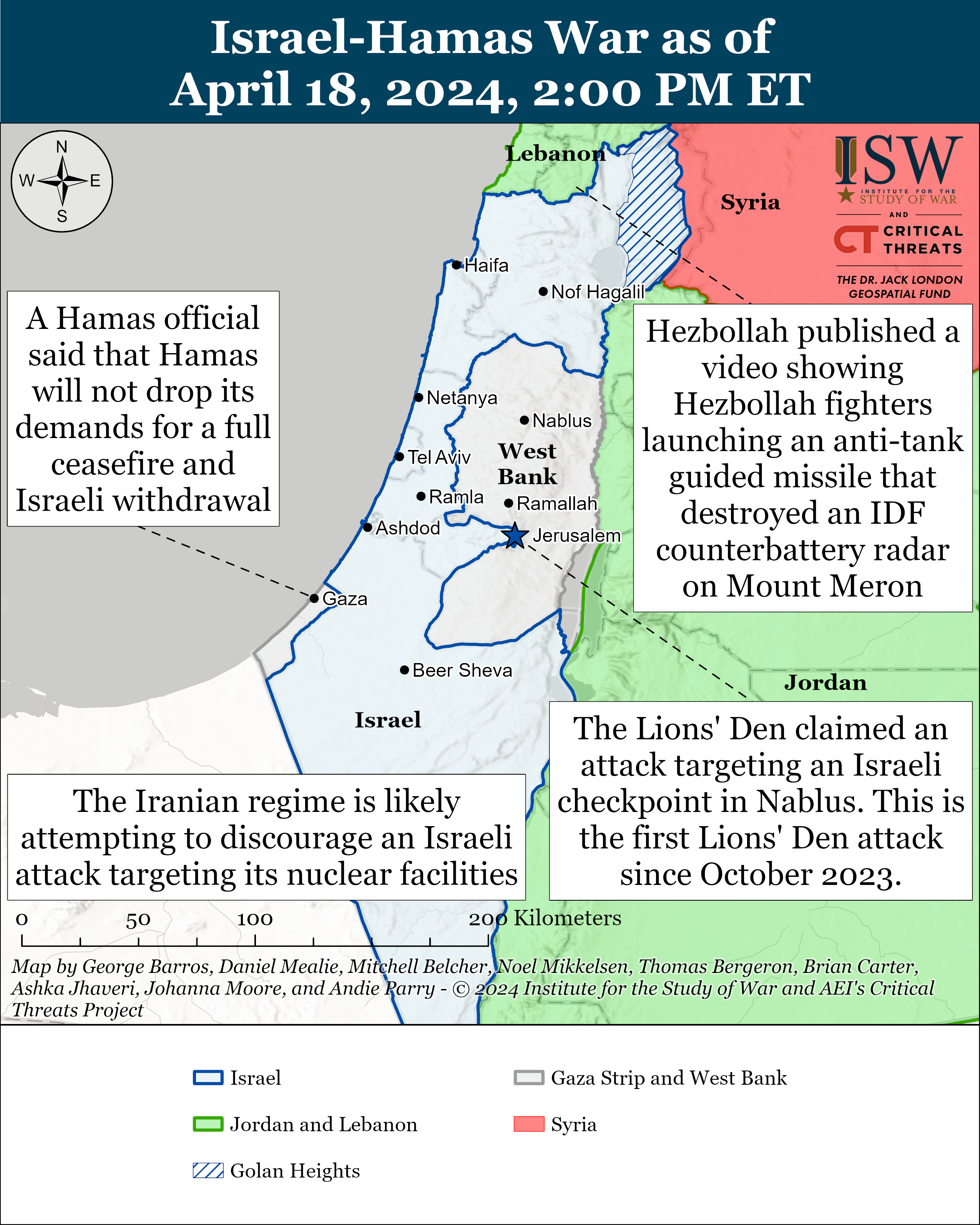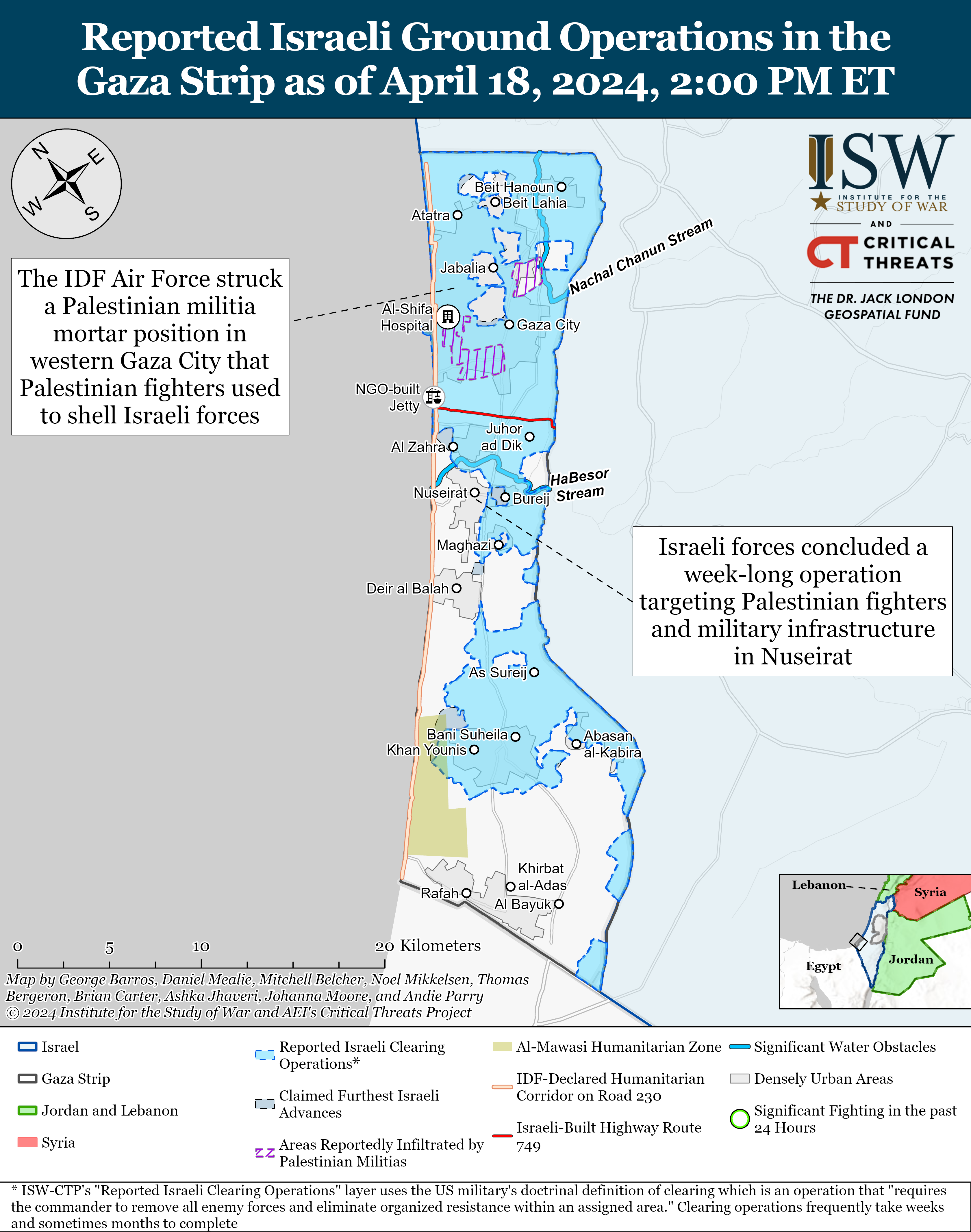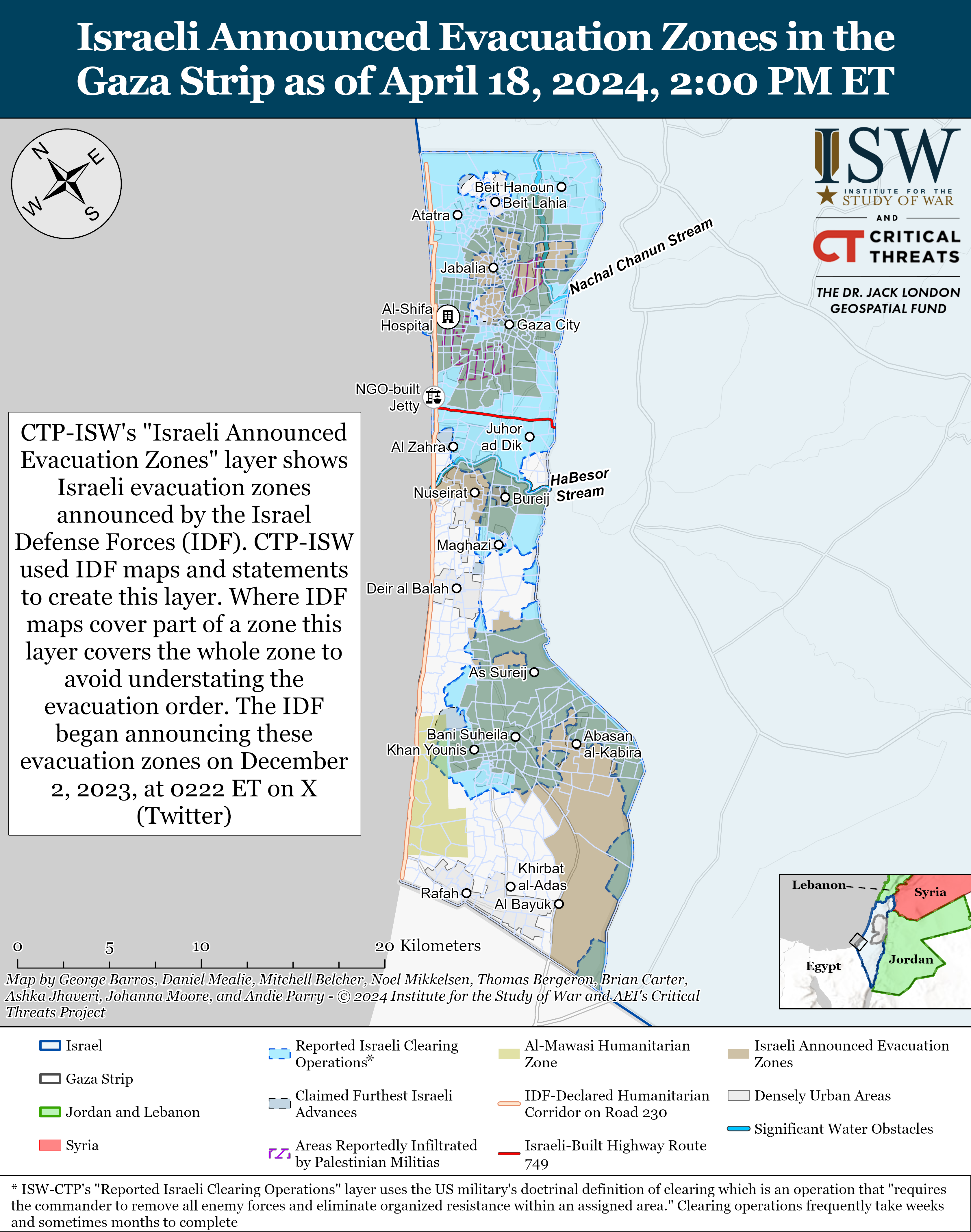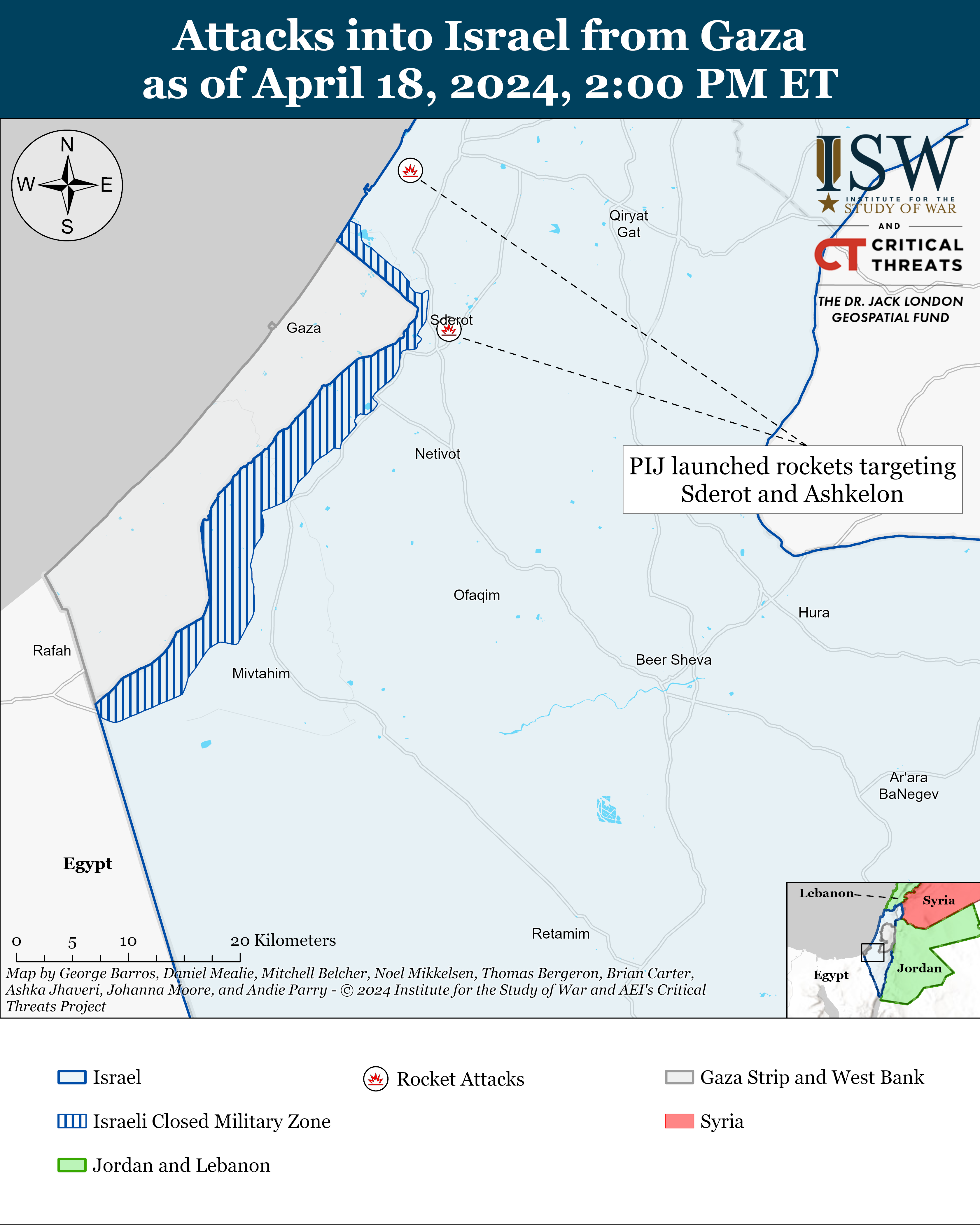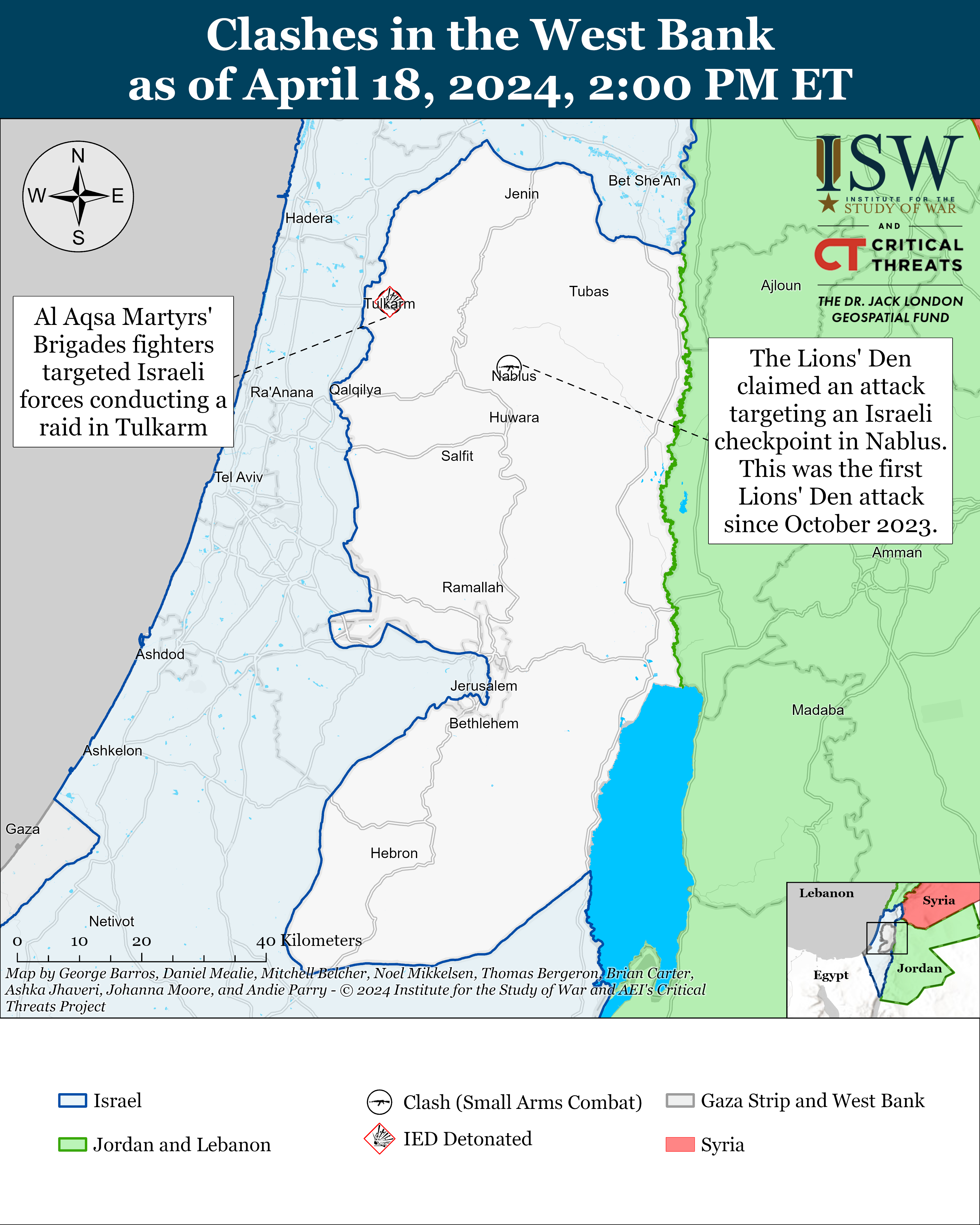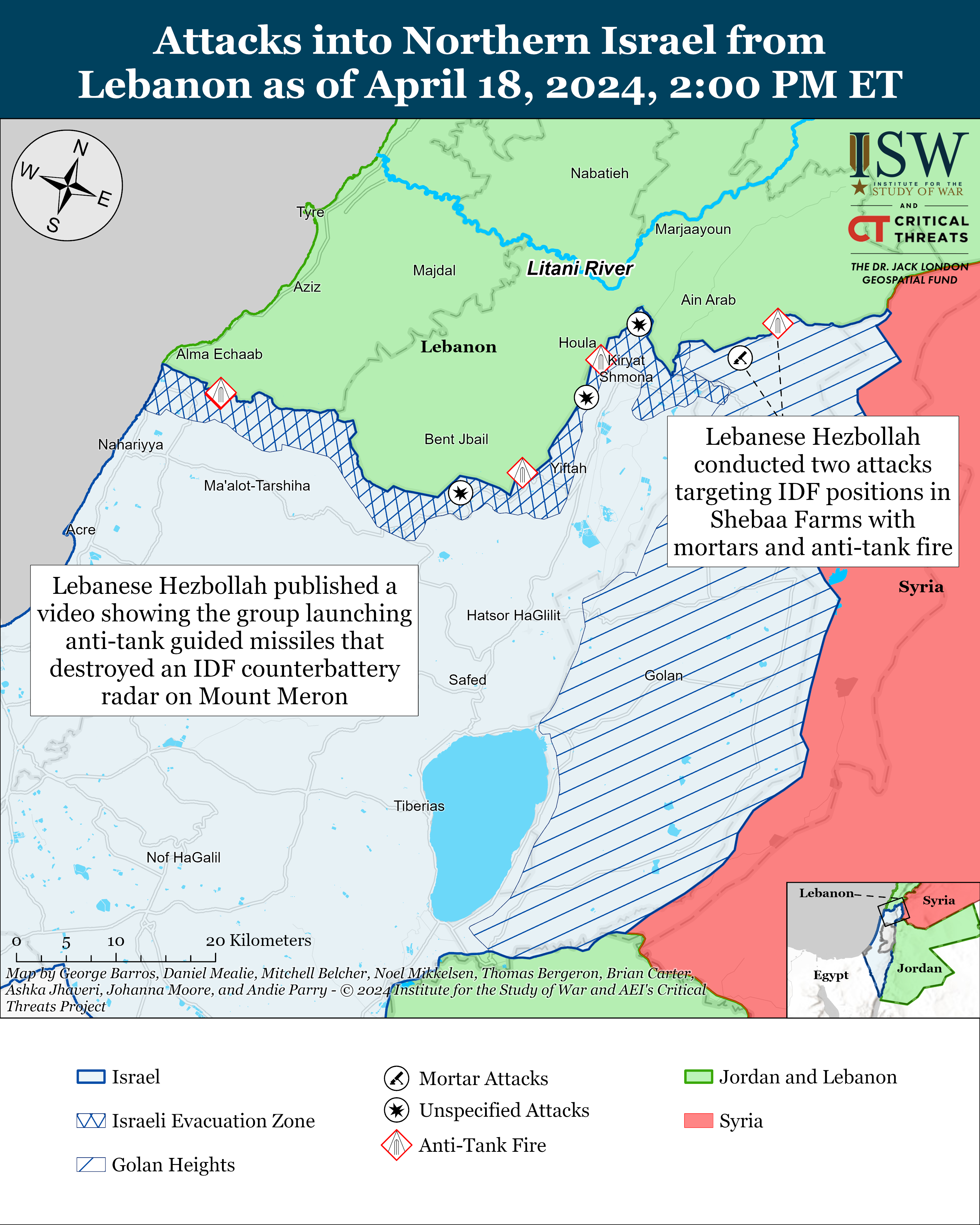Frederick W. Kagan, Ashka Jhaveri, Annika Ganzeveld, Nicholas Carl, and George Barros
April 18, 2024
A Russian victory is an Iranian victory. Moscow and Tehran have formed a military bloc with the aim of defeating the United States and its allies in the Middle East, Europe, and around the world. Russian and Iranian military forces have been fighting alongside one another in Syria for nearly a decade. The Russians have given Iran advanced air defenses and access to other military technologies and techniques, in addition to a front-row seat observing their efforts to defeat American and NATO missile defenses in Ukraine.[1] The Iranians in turn have given the Russians drones and access to drone technologies, including assisting with the construction of a massive factory to turn out thousands of Iranian drones in Russia.[2] Further Russian support to Iran has been limited in part because of the setbacks Russia has suffered in Ukraine. A victorious Russia will be free to give Iran the advanced aircraft and missile technologies Tehran has long sought.[3] If Russia gains control of Ukraine’s resources, as it seeks to do, it will be able to rebuild its own military and help Iran at the same time. Those concerned with the growth of Iran’s military power, ambitions, and aggression in the Middle East must recognize the degree to which Iran’s fortunes rise and fall with Russia’s.
The Russo-Iranian military coalition was formed in 2015 when Islamic Revolutionary Guards Corps (IRGC) Quds Force Commander Major General Qassem Soleimani went to Moscow to seek help in keeping Bashar al Assad in power in Syria.[4] The Russians sent their own combat aircraft, intelligence and electronic warfare assets, and SPETSNAZ (special forces), along with a limited contingent of ground forces to help Soleimani.[5] Russian forces provided air support to Iranian troops and proxies, including Lebanese Hezbollah and Iranian-controlled Iraqi militias, fighting against the anti-Assad opposition—especially the part of that opposition that the United States supported.[6] Russian forces remain in Syria to this day, operating in support of the expanding Iranian presence there.[7]
The Iranians learned a great deal from the combined military operations they conducted with the Russians in Syria, including how to plan and conduct complex ground campaigns and how to incorporate fixed-wing air support with ground troops.[8] The Russians benefited in turn by establishing a major airbase near Latakia and a naval base at Tartus, both effectively defended by the ground forces of Assad, Iran, and Iranian proxies.[9] Russian air and naval forces remain in both locations.
The Russians entered the Syrian Civil War ostensibly to fight the Islamic State of Iraq and al Sham (ISIS), but they did little against ISIS. Their main focus was on helping Assad destroy the moderate opposition and retaining, then solidifying his hold on power.[10] The Russian forces in Syria regularly interfered with and constrained the operations of US aircraft attempting to support US forces and allies who were actually fighting ISIS.[11] The Russians forced the United States to establish deconfliction procedures that effectively divided Syria in half.[12] The United States and its partners focused on defeating ISIS in the northeast, while the Russians and the Iranians focused on strengthening their positions in the southwest even as ISIS retained positions there.[13]
Russo-Iranian military cooperation has expanded dramatically since Russia’s full-scale invasion of Ukraine. The Iranians began sending hundreds of reconnaissance and long-range attack drones to Russia in August 2022 as the Russians exhausted their supply of missiles.[14] Those drones let Russia maintain and increase its pressure on Ukrainian air defenses even as it worked to expand production and modification of its own missile systems. The Iranians even helped Russia build a massive factory in the Republic of Tatarstan able to produce thousands of such drones.[15] The Russians have given Syria short-range air defense systems such as the Pantsir, which Syrian forces reportedly used in vain attempts to shoot down Israeli aircraft.[16]
Russian and Iranian military officials have been closely coordinating mutual military and security assistance. Iranian Law Enforcement Commander Brigadier General Ahmad Reza Radan, who is responsible for internal security and repression in Iran, flew to Moscow in June 2023 to discuss expanding cooperation on internal security matters with Russian security service heads.[17] Radan’s visit notably occurred a few days after the failed armed mutiny of Wagner Group financier Yevgeny Prigozhin, which prompted a renewed emphasis on Russian internal security. The Iranian army’s Ground Forces Commander Brigadier General Kiomars Heydari met with his Russian counterpart, General Oleg Salyukov, in August 2023 to discuss increasing cooperation.[18] Russian Minister of Defense Sergei Shoigu went to Tehran in September 2023 for the same purpose.[19] IRGC Aerospace Forces Commander Brigadier General Amir Ali Hajji Zadeh took Shoigu on a tour of Iran’s drone, missile, and air defense arsenal at the IRGC Aerospace Forces headquarters.[20] Shoigu also met Iranian Minister of Defense and Armed Forces Logistics Brigadier General Mohammad Reza Ashtiani on that trip.[21] The Chief of Iran’s Armed Forces General Staff (roughly equivalent to the US Chairman of the Joint Chief of Staff), Major General Mohammad Bagheri, spoke with Shoigu on October 19, 2023, to discuss the Israel-Hamas war.[22] The secretary of Iran’s Supreme National Security Council (roughly equivalent to the US National Security Adviser) met with Russian President Vladimir Putin’s Special Representative for Syrian Affairs, Alexander Lavrentiev, in Tehran on November 1, 2023, to discuss political and security cooperation and coordination in Syria.[23] Russian Defense Minister Shoigu spoke with Iranian Defense Minister Ashtiani once more on January 15, 2024. And Rustam Minnikhanov, chairman of the board of directors of the Tupolev aircraft manufacturing firm and head of the Russian Republic of Tatarstan where Iran has been helping Russia build a massive drone factory, made an official visit to Iran on February 14, 2024.[24] Minnikhanov visited Esfahan, the heart of Iran’s military industry and especially the aerospace industry.[25]
These high-level engagements are remarkable for their frequency during periods when both Russian and Iranian senior military officials should have been fully occupied with their own problems—the war in Ukraine in Russia’s case, and the Israel-Hamas War in Iran’s. Lower-level but possibly more significant technical experts have also been on the move. Seventeen Iranian officials reportedly visited a Russian air defense system plant in Yekaterinburg in March 2023.[26] The plant, under US sanctions for supporting Russia’s war in Ukraine, produces mobile launchers and other components of anti-aircraft systems including the advanced S-400 system.[27]
Russia has been providing concrete assistance to Iran beyond the S-300 batteries it delivered in 2016. The Russians launched an Iranian Khayyam remote-sensing satellite into space in August 2022.[28] Russia reportedly provides Iran with advanced surveillance software, cash, and technical assistance to Iran’s Space Launch Vehicle (SLV) and missile program.[29] The SLV program is particularly significant because it can support the development of nuclear-capable intercontinental ballistic missiles (ICBMs). The Russians delivered two Yak-130 combat trainer aircraft to Iran on September 2, 2023, likely as a down-payment on the delivery of the more advanced Su-35 fighter-bombers Iran has been requesting for some years.[30] The Russians have also reportedly been sharing captured US and NATO weapons, including Javelin anti-tank and Stinger anti-aircraft systems, with Iran presumably so that both sides can reverse-engineer them and develop counter-measures to them.[31] Russia and Iran were reportedly in negotiations with China to help Iran replenish its supplies of a key component of its solid-rocket fuel supply chain, although the outcome of that effort is not clear.[32] The Iranians have also reportedly asked Russia for help obtaining additional nuclear materials and with nuclear fuel fabrication.[33]
Russo-Iranian military collaboration very likely shaped the design of Iran’s failed April 13, 2024, drone-missile strike on Israel, since the combination of drones, cruise missiles, and ballistic missiles Iran used mirrored packages the Russians have developed to penetrate US- and NATO-provided missile defenses in Ukraine.[34] The failure of that package to get more than a handful of ballistic missiles through should not generate complacency, especially since the Iranians now better understand what volume and combination of types of munitions they may need to penetrate Israeli air defenses. The Russians have moreover demonstrated in Ukraine that repeated attempts to find vulnerabilities in missile defense systems can ultimately succeed—and have shown that they are willing to share their insights with Iran.
The Iranians have maintained a long list of Russian combat systems they desire for many years. The list includes the Su-35 and the Su-34, as well as S-400 air defense systems, tanks, and many other pieces of military hardware.[35] The Russians have historically dithered in giving Iran such advanced systems.[36] Before the full-scale invasion of Ukraine, Russian dithering likely resulted from Moscow’s efforts to balance between supporting Iran and maintaining good relations with Israel and the Arab States — all of whom would be seriously alarmed and alienated by the provision of such weapons to Iran. Since the invasion, the Russians have not had such systems to spare. But Putin has moved closer and closer to siding openly with Iran against Israel. The victorious end of Putin’s war in Ukraine would lift the material constraints on the provision of advanced military equipment to Iran.
The days of Russia balancing between Iran and Israel appear to be coming to an end, in fact. The Russians have become loud advocates of a ceasefire in Gaza, which Israel opposes, and have repeatedly hosted representatives of Hamas, Palestinian Islamic Jihad, and other Iran-aligned militias in Moscow.[37] Iranian Deputy Minister of Foreign Affairs Ali Bagheri Kani met his Russian counterpart, Sergei Ryabkov, in Moscow on October 26.[38] Hamas Politburo Member Musa Abu Marzouk was in Moscow at the same time and met Bagheri Kani there on October 27.[39] Iranian and Russian officials continued coordinating on the Israel-Hamas war in November 2023, and the readout of such a meeting in late December 2023 concluded that the Russians and Iranians were discussing “political ways” to end the Israeli ground operation in Gaza, force an immediate ceasefire, and provide humanitarian aid to Gazans.[40] Reports from about this time indicated that the Russians might even have been considering sending air defense systems to Hezbollah.[41] These efforts culminated in a March 19, 2024, conversation between Iranian President Ebrahim Raisi and Russian President Putin in which Putin said that he was “ready to cooperate more and more effectively” with Iran about the “Palestinian issue” and that Russia and Iran share the same position on that issue.[42]
Constraints on Russia’s ability to supply Iran with advanced weaponry will also begin lifting if Russia defeats Ukraine. Ukrainian forces supplied with Western weapons have wrought havoc on Russian systems, destroying thousands of tanks and armored personnel carriers as well as aircraft and air defense systems. The Russian defense industry has been racing to make good Russian losses, and its inability to do so has led in part to Russia’s desperation for Iranian (and North Korean and Chinese) military assistance. Ukraine once defeated, however, the Russian defense industry will remain mobilized first to rebuild the Russian army, but then to resume the export of advanced military systems interrupted by the war. The increasingly close relationship between Russia and Iran spurred by Iran’s stalwart support for the Russian war effort makes the prospect that Russia will ultimately follow through on promises to give Iran some of its most advanced military systems much likelier than it has ever been.
There is little reason to expect that the West can drive a wedge between Moscow and Tehran at this point. Russian rhetoric and actions have become ferociously anti-Western and have come to share many of the overtones of civilizational conflict that have long characterized Iranian ideology. The fact that Russia seeks, in principle, to build an anti-Western Christian civilization whereas Tehran desires an anti-Western Muslim one is not material as long as both agree that defeating the United States and its allies is the top priority, as they do.
The primary constraint on Russian support to Iran, therefore, is Russia’s weakness. A Russia battered by failure in Ukraine, licking its wounds, and facing a strong and independent Ukrainian state will have limited resources and energy to devote to helping Iran. A Russia triumphant over the United States and NATO in Ukraine and with the resources of Ukraine at its disposal, on the other hand, will have ample capacity to repay its friends and support them in their efforts to achieve an aim Russia shares — defeating the United States and expelling it from the Middle East.
The notion that the United States should allow Russia to win in Ukraine in order to resist Iran in the Middle East is thus indefensible. Americans must internalize the unpleasant reality that the Russo-Iranian military bloc is a real and vibrant thing, that Moscow will support Tehran against us and our allies as best it can, and that Russia’s victory is Iran’s victory. Russia’s loss, contrariwise, is Iran’s loss. Those wishing to contain Iran therefore must also support helping Ukraine against Russia.

[1] https://www.washingtonpost.com/national-security/2024/04/15/iran-israel-russia-drones-missiles/;
https://apnews.com/article/iran-russia-fighter-drone-495c0018a9af2443e767b8ccd39801e4;
https://t.me/rybar/43630
[2] https://apnews.com/article/russia-iran-drone-factory-ukraine-war-dfdfb4602fecb0fe65935cb24c82421a
[3] https://amwaj.media/media-monitor/downplaying-speculation-iran-hedges-on-su-35-purchase-from-russia
[4] https://www.reuters.com/article/idUSKCN0S02BV/
[5] https://www.washingtonpost.com/news/checkpoint/wp/2016/03/29/how-russian-special-forces-are-shaping-the-fight-in-syria/;
https://understandingwar.org/sites/default/files/Russian%20Deployment%20to%20Syria%2017%20September%202015%20(1).pdf
[6] https://www.nytimes.com/2015/10/13/world/middleeast/syria-russia-airstrikes.html l
https://www.understandingwar.org/sites/default/files/Russian%20Airstrikes%20Maps%20SEPT%202015-SEPT%202016.pdf
[7] https://understandingwar.org/backgrounder/iran-russia-and-syrian-regime-are-coordinating-expel-us-forces-syria
[8] https://www.understandingwar.org/backgrounder/how-iran-learning-russia-syria
[9] https://www.washingtonpost.com/news/checkpoint/wp/2016/03/29/how-russian-special-forces-are-shaping-the-fight-in-syria/
[10] https://www.aljazeera dot com/features/2020/10/1/what-has-russia-gained-from-five-years-of-fighting-in-syria
[11] https://www.cbsnews.com/news/us-and-russia-remain-at-odds-in-skies-over-syria/
[12] https://www.washingtonpost.com/news/checkpoint/wp/2017/12/14/u-s-f-22s-fired-warning-flares-at-russian-planes-in-close-call-over-syria-pentagon-says/ ;
https://www.atlanticcouncil.org/blogs/syriasource/syria-s-buffer-zone-along-the-euphrates/
[13] https://www.cnn.com/2018/01/08/politics/us-russia-hindering-isis-fight-syria/index.html
[14] https://www.dia.mil/Portals/110/Documents/News/Military_Power_Publications/UAV_Book.pdf ; https://iranprimer.usip.org/blog/2023/mar/01/timeline-iran-russia-collaboration-drones
[15] https://apnews.com/article/russia-iran-drone-factory-ukraine-war-dfdfb4602fecb0fe65935cb24c82421a
[16] https://www.reuters.com/article/idUSKCN0RB1Q0/
[17] https://www.tasnimnews dot com/en/news/2023/06/27/2917418
[18] https://en.irna dot ir/news/85206058/Iran-Russia-army-ground-forces-agree-to-boost-cooperation
[19] https://www.irna dot ir/news/85233000
[20] https://www.mashreghnews dot ir/news/1528556
[21] https://defapress dot ir/fa/news/617459
[22] https://defapress dot ir/fa/news/624279
[23] https://www.tasnimnews dot com/en/news/2023/11/02/2982001
[24] https://www.iribnews dot ir/fa/news/4154810
[25] https://ostan-es dot ir/24250/%D8%AA%D8%B4%DA%A9%DB%8C%D9%84-%DA%A9%D8%A7%D8%B1%DA%AF%D8%B1%D9%88%D9%87-%D9%85%D8%B4%D8%AA%D8%B1%DA%A9-%D8%AF%D8%B1-%D8%B1%D8%A7%D8%B3%D8%AA%D8%A7%DB%8C-%DA%AF%D8%B3%D8%AA%D8%B1%D8%B4-%D8%B1%D9%88/
[26] https://www.washingtonpost.com/national-security/2024/04/15/iran-israel-russia-drones-missiles/
[27] https://www.washingtonpost.com/national-security/2024/04/15/iran-israel-russia-drones-missiles/; https://sanctionssearch.ofac.treas.gov/Details.aspx?id=17259
[28] https://www.reuters.com/world/russia-launches-iranian-satellite-into-space-under-shadow-western-concerns-2022-08-09/
[29] https://ru.usembassy.gov/fireside-chat-with-director-william-burns-aspen-security-forum-2023/; https://www.cia.gov/stories/story/director-burns-remarks-at-the-aspen-security-forum-2023/
[30] https://www.forbes.com/sites/pauliddon/2023/09/02/iran-reportedly-receives-russian-jets-but-they-arent-the-long-sought-after-su-35-flanker/?sh=2c4b758f2a2f
[31] https://www.cnn.com/2023/03/10/politics/russia-iran-ukraine-weapons/index.html
[32] https://www.politico.eu/article/vladimir-putin-ukraine-war-xi-jinping-china-russia-in-secret-talks-to-supply-iran-missile-propellant/
[33] https://www.cnn.com/2022/11/04/politics/iran-russia-nuclear-program/index.html
[34] https://www.understandingwar.org/backgrounder/iran%E2%80%99s-attempt-hit-israel-russian-style-strike-package-failedfor-now
[35] https://www.nbcnews.com/politics/russia-providing-unprecedented-military-support-iran-exchange-drones-o-rcna60921; https://www.washingtonpost.com/national-security/2024/04/15/iran-israel-russia-drones-missiles/; https://www.telegraph.co.uk/news/2016/11/14/russia-may-sell-iran-10-billion-worth-of-tanks-and-jets-in-new-a/
[36] https://www.washingtonpost.com/national-security/2024/04/15/iran-israel-russia-drones-missiles/
[37] https://www.middleeastmonitor.com/20230316-hamas-sent-high-level-delegation-to-moscow-at-russias-invitation/; https://tass dot ru/politika/20002887; https://theins dot ru/news/269255; https://www.pravda dot com.ua/eng/news/2024/02/18/7442422/
[38] https://www.irna dot ir/news/85271712
[39] https://www.farsnews dot ir/news/14020805000283
[40] https://www.farsnews dot ir/news/14021003000248
[41] https://www.reuters.com/world/us-intelligence-thinks-wagner-plans-send-air-defence-system-hezbollah-wsj-2023-11-03/; https://www.cnn.com/2023/11/02/politics/syrias-assad-hezbollah-wagner-missile-system/index.html
[42] https://en dot mehrnews.com/news/213182/Russia-Iran-share-positions-regarding-Palestine-issue; https://www.tasnimnews dot com/fa/news/1402/12/29/3057257/
